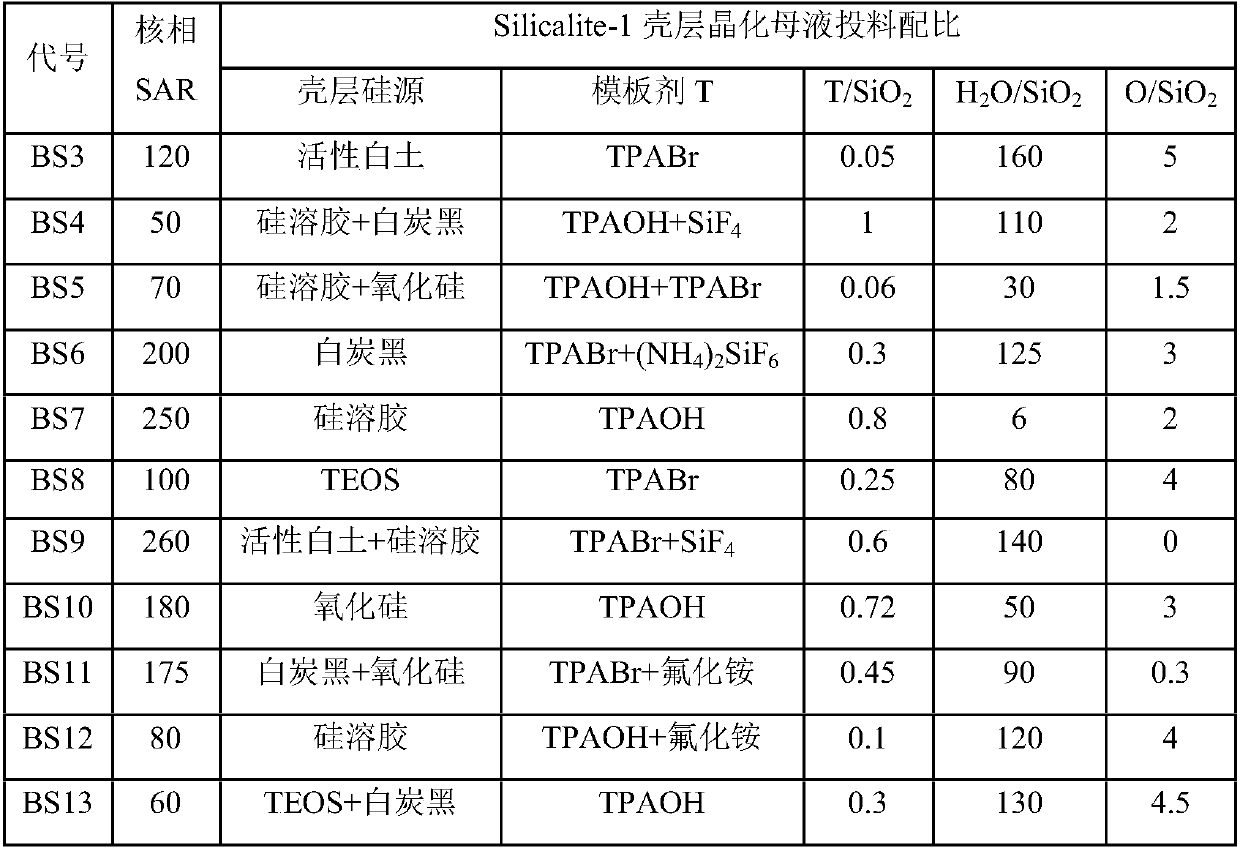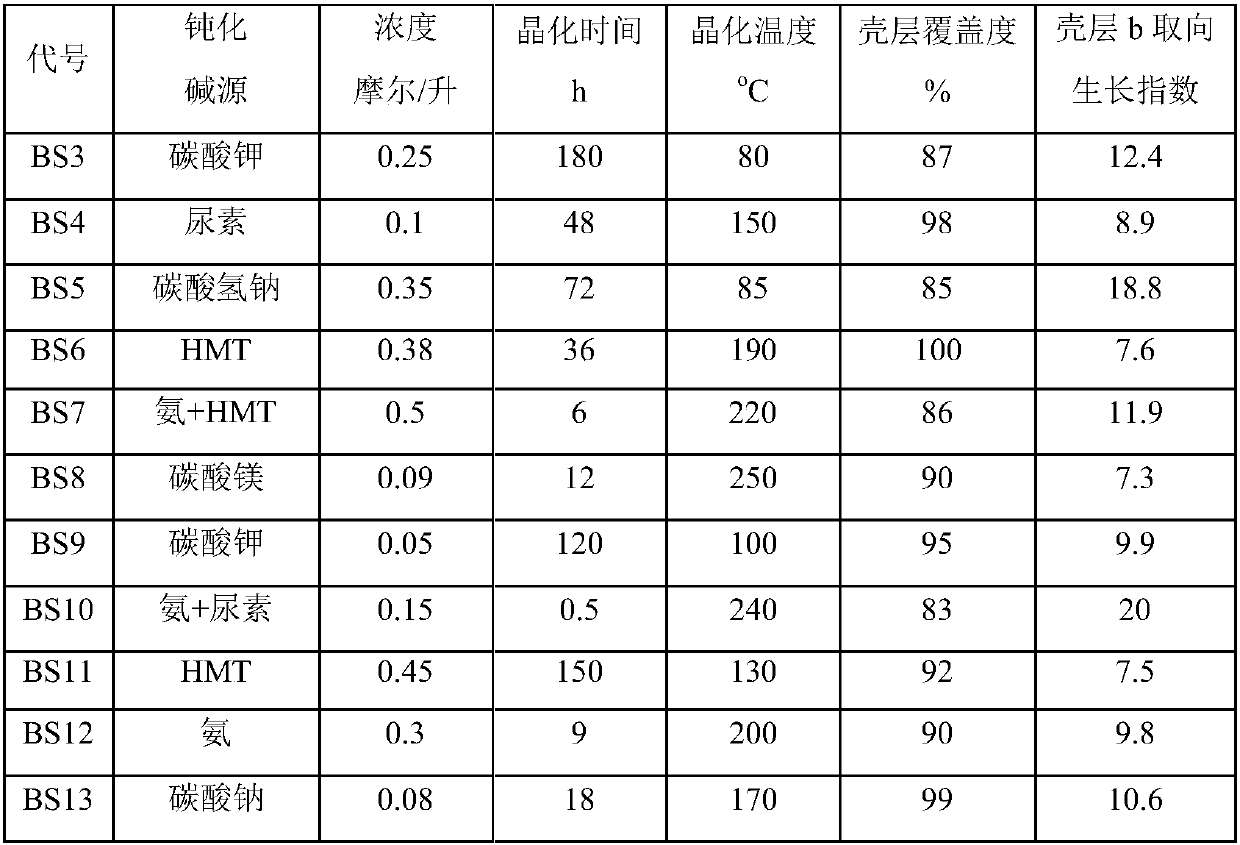Zsm-5/silicalite-1 core-shell molecular sieves with shell-oriented epitaxial intergrowth
A core-shell molecular sieve and epitaxial symbiosis technology, which is applied in the direction of molecular sieve catalysts, bulk chemical production, chemical/physical processes, etc., can solve the problem of waste of shell raw materials and templates, poor catalyst activity and stability, and non-epitaxial symbiosis of shells and other problems, to achieve the effect of simplifying the preparation method, simplifying the symbiosis control of orientation and epitaxy, and having a strong tendency
- Summary
- Abstract
- Description
- Claims
- Application Information
AI Technical Summary
Problems solved by technology
Method used
Image
Examples
Embodiment 1
[0022] Dissolve 360 grams of silica sol (wt.40%) in 200 grams of water to configure solution A; dissolve 7 grams of aluminum sulfate in 100 grams of water to configure solution B; dissolve 3 grams of potassium sulfate in 240 grams of water to configure into solution C. Slowly add solution B to solution A dropwise, stir well, then add solution C, the formed reaction mixture is crystallized at 170°C for 2 days, filtered, and dried at low temperature to obtain large-grain nuclear phase ZSM-5 molecular sieves.
[0023] 320 grams of unroasted ZSM-5 raw powder is used as a nuclear phase molecular sieve, with a molar silicon-aluminum ratio of 100, added to 0.05 mol / liter urea aqueous solution, heated to 80°C under stirring and kept for 2 hours, filtered and heated at 120°C The ZSM-5 nuclear phase molecular sieve after outer surface treatment is obtained by drying in the air atmosphere.
[0024] 120 grams of white carbon black, 10 grams of silicon tetrafluoride, 800 grams of tetrae...
Embodiment 2
[0026] Dissolve 600 grams of water glass in 900 grams of water to form solution A; dissolve 25 grams of aluminum sulfate in 300 grams of water to form solution B; dissolve 20 grams of sodium sulfate in 200 grams of water to form solution C. Slowly add solution B to solution A dropwise, stir well, then add solution C, and the formed reaction mixture is crystallized at 140°C for 4 days, filtered, and dried at low temperature to obtain a small-grain nuclear phase ZSM-5 molecular sieve.
[0027] 40 grams of unroasted ZSM-5 raw powder is used as a nuclear phase molecular sieve, with a molar silicon-aluminum ratio of 40, added to a 0.05 mol / liter HMT aqueous solution, heated to 90°C under stirring and kept for 3 hours, filtered and cooled in 120°C air The ZSM-5 nuclear phase molecular sieve after the outer surface treatment is obtained by drying in the atmosphere.
[0028] 35 grams of TEOS, 6 grams of TPABr, and 180 milliliters of water were uniformly stirred to form a gel to obtain...
Embodiment 14-19
[0041] In Examples 14 to 19, samples BS-1 and BS-2 of core-shell molecular sieves BS-1 and BS-2 were used as catalysts for the production of p-xylene, respectively, with shell-oriented epitaxial symbiosis ZSM-5 / silicalite-1 core-shell molecular sieve samples. The results are shown in Table 2.
[0042] Table 2
[0043]
PUM
| Property | Measurement | Unit |
|---|---|---|
| particle diameter | aaaaa | aaaaa |
| thickness | aaaaa | aaaaa |
Abstract
Description
Claims
Application Information
 Login to View More
Login to View More - Generate Ideas
- Intellectual Property
- Life Sciences
- Materials
- Tech Scout
- Unparalleled Data Quality
- Higher Quality Content
- 60% Fewer Hallucinations
Browse by: Latest US Patents, China's latest patents, Technical Efficacy Thesaurus, Application Domain, Technology Topic, Popular Technical Reports.
© 2025 PatSnap. All rights reserved.Legal|Privacy policy|Modern Slavery Act Transparency Statement|Sitemap|About US| Contact US: help@patsnap.com



